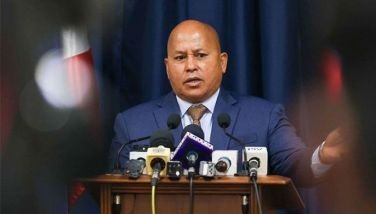Phl gets Category 1 aviation safety upgrade
MANILA, Philippines - Six years after being barred from expanding services in the United States due to safety concerns, Philippine carriers are now allowed more flights to US destinations after the Federal Aviation Administration (FAA) restored the Category 1 status of the local commercial aviation industry.
Ambassador Philip Goldberg made the announcement yesterday on his Twitter account @AMBGoldberg.
“Good News! Philippines compliance with international #aviation safety oversight standards earn Category 1 Safety Rating,†Goldberg tweeted.
The Philippines was downgraded to Category 2 status in 2008.
“This upgrade cements a landmark era in the Philippine aviation sector. From one major achievement to another in a span of less than two years, the country has made great strides in enhancing its aviation industry to one that is at par with the best in the world,†Transportation and Communications Secretary Joseph Emilio Abaya said.
He cited an earlier lifting of a European ban on local carriers also due to safety concerns.
He lauded the Civil Aviation Authority of the Philippines (CAAP) led by Lt. Gen. William Hotchkiss III and Capt. John Andrews for working vigorously to address the remaining aviation safety concerns raised by the International Civil Aviation Organization (ICAO) of the United Nations.
“We congratulate the CAAP for a job well done in ensuring the lifting of the ICAO’s significant safety concerns, the lifting of the European ban on local airlines, and now, the FAA upgrade to Category 1,†the DOTC chief said.
“There are no more restrictions,†Andrews said in a television interview. “We are now world-class as far as the aviation industry is concerned.â€
A country on Category 2 status means it lacks laws or regulations necessary to oversee air carriers in accordance with minimum international standards, or that its civil aviation authority – equivalent to the FAA for aviation safety matters – is deficient in one or more areas, such as technical expertise, trained personnel, record keeping or inspection procedures.
Goldberg personally handed over to Hotchkiss a letter from FAA associate administrator for aviation safety Margaret Gilligan confirming the upgrade to Category 1.
Abaya pointed out that the upgrade would boost the country’s tourism industry, help airline companies expand their operations, and improve trade and business relations between the Philippines and the US.
“Philippine air carriers can now open more flights to the United States and have additional routes such as flying to the East Coast,†Abaya said.
Carmelo Arcilla, executive director of the Civil Aeronautics Board (CAB), said the development affirms the resolve of CAAP to show that Philippine aviation is at par with international standards.
“This means that the incumbent Philippine carriers, particularly PAL, may now expand operations into the US. Other carriers that meet operational requirements in terms of equipment and organization may now apply for designation as official Philippine carriers for the purpose of operating in the Philippine-US market,†he said in a text message.
“Ultimately, this is a triumph not just for the government or our carriers, but for the riding public that will have improved options for air travel that are assuredly world class,†he added.
Hard work
PAL, jointly owned by taipan Lucio Tan and conglomerate San Miguel Corp. (SMC), is in the middle of a massive re-fleeting program involving the acquisition of 100 new aircraft in anticipation of mounting long haul flights to US and Europe.
“Your flag carrier welcomes the return of the country’s aviation rating to Category 1. This is a culmination of the government’s hard work, as exemplified by the efforts of the Civil Aviation Authority of the Philippines to upgrade the country’s international safety standards,†PAL president and chief operating officer Ramon Ang said.
“This latest development allows us to deploy our modern and fuel-efficient Boeing 777-300ER fleet to the US, and enables us to explore new destination opportunities in one of the Philippines’ largest passenger markets,†he said.
Ang added that the upgrade would also allow PAL to explore partnerships with foreign carriers to maximize its growth potential. He said PAL is likely to realize savings of $100 million in fuel and maintenance costs per year from newer and more fuel-efficient aircraft.
Currently, PAL operates a total of 26 weekly flights to the US, with frequencies to Los Angeles, San Francisco, Honolulu and Guam.
The flag carrier said it would deploy six Boeing 777-300ERs, amounting to $1.2 billion, for US flights within a month’s time.
For its flights to Honolulu and Guam, PAL will continue to utilize new wide body Airbus A330-300s and single-aisle A320-200s.
PAL, Asia’s first airline, entered into two separate purchase agreements with Airbus in August and September 2012.
The first purchase agreement worth $7 billion is for 44 Airbus A320 aircraft and options for 20 Airbus A320 for delivery beginning this year to 2020, while the other agreement worth $2.5 billion is for a firm order for 10 Airbus A330-300 aircraft and options for 10 aircraft for delivery up to 2016.
Based on its website, the airline has an operating fleet of 53 aircraft consisting of six Boeing 777-300ER, four Boeing 747-400, eight Airbus A340-300, 13 A330-300, 12 A320-200, six A321-231 and four A319-100.
PAL got the green light from the European Union in July last year to service European destinations, paving the way for the launch of direct flights to London in November.
On the other hand, budget airline Cebu Pacific (Cebu Air) of John Gokongwei Jr. is also looking at mounting flights to the US.
Cebu Pacific has embarked on a $4-billion re-fleeting program involving the acquisition of 49 Airbus aircraft. Shares of Philippine Airlines rose by as much as 2.9 percent, while Cebu Air climbed as much as 4.3 percent in early trading after the FAA announcement.
Tony Fernandes, chief executive of low-cost carrier AirAsia, welcomed the FAA upgrade.
“Great news Philippines they have got back category status from FAA,†he said on Twitter. “Means Air Asia Philippines can now have access to routes.â€
‘Economic diplomacy’
Philippine Ambassador to the US Jose Cuisia Jr. said steering back the country to Category 1 status “has been one of our major economic diplomacy thrusts in the United States.â€
“With the Category 1 rating, we hope to see the expansion of flight routes in the US by Philippine air carriers,†he said.
“This means opening up more routes for business and tourism travel between the Philippines and the US as well as creating more opportunities for Philippine and American business,†he added.
Timeline
Jan. 17, 2008 – The US Federal Aviation Authority (FAA) downgraded the Philippines’ rating to Category 2 from Category 1, since its Air Transportation Office (ATO) did not fully satisfy international safety standards. The FAA decision prevented Philippine Airlines (PAL) from increasing its US flights from 33 per week.
April 1, 2010 – The European Union, following the FAA’s lead, banned Philippine carriers from flying to Europe.
June 19, 2010 – Vital navigation equipment at the Manila international airport maintained by CAAP failed. The VHF omnidirectional range (VOR) used by aircraft for navigating to and from the airport stopped working due to heavy rain and no replacement was available.
Feb. 18-22, 2013 – The International Civil Aviation Organization (ICAO) of the United Nations conducted an audit on the Philippines regarding the remaining significant safety concerns (SSCs).
March 7, 2013 – The ICAO officially delisted the Philippines from its tally of member states with unresolved SSCs. The ICAO Council formally stated that the Philippines has “implemented corrective actions in accordance with the mechanism approved by the Council to resolve two SSCs – the issuance of air operator certificates and the aircraft registration process.â€
July 10, 2013 – EU Ambassador to the Philippines Guy Ledoux announced the lifting of a ban on PAL from flying into its airspace after the national carrier resolved aviation safety concerns starting July 12, 2013. PAL president and CEO Ramon Ang said the airline intends to mount direct flights to London, Paris, Rome and Amsterdam.
Nov. 1, 2013 – PAL mounts direct flights to London.
Nov. 23, 2013 – A team composed of US-FAA division manager for Flights Standards Service John Barbagallo and area manager for Asia Pacific James Spillane was supposed to visit the country but the audit did not push through.
Jan. 20, 2014 – A team from US-FAA conducted the audit.
Jan. 28, 2014 – Cebu Pacific informed the Directorate General for Mobility and Transport (DGMOVE) of the EU in Brussels that the low-cost carrier has complied with all the outstanding aviation safety concerns just like national flag carrier PAL.
March 26, 2014 – A team headed by Barbagallo conducted a validating audit on the findings of the audit conducted by a team last January.
Cebu Pacific was also invited to attend the Air Safety Committee meeting of the EU in Brussels.
April 10, 2014 – The Civil Aviation Authority of the Philippines (CAAP) announced the upgrading to Category 1 status by the US FAA through its website and the concurrent visit of US Ambassador Philip Goldberg to the office of CAAP Director General William Hotchkiss III to inform him that the Philippines has been upgraded to Category 1.
A letter dated April 9, 2014 confirming the upgrade from Margaret Gilligan, associate administrator for aviation safety of the US-FAA, was personally handed over by Goldberg to Hotchkiss. Philippine carriers will now be allowed to mount additional flights to and from the US as well as add new routes to the US. With Pia Lee-Brago, Rudy Santos
- Latest
- Trending





























